The sitter stares directly at the viewer, standing confidently with his legs apart (fig.1). He is a young man, with a slight beard. His right hand rests on the belt around his waist, while in his left hand he grasps a pair of gloves and a finely patterned rapier hilt. He wears a soft black hat with a narrow brim, decorated with small gold ornaments and a down-turned plain white feather. He is dressed in a heavy, black, thigh-length cloak with gold trimming, a white shirt embroidered with gold and black thread in a pattern of plant stems and acorns, a black jerkin with vertical slashes that reveal a red doublet underneath, and black hose with a prominent black codpiece.
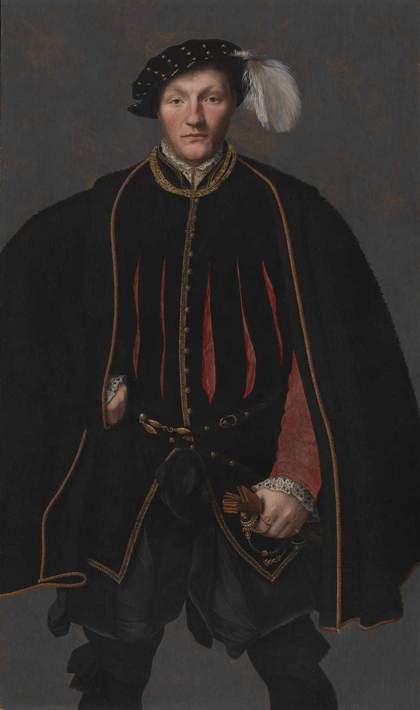
Fig.1
?British School, 16th Century
Portrait of a Gentleman, probably of the West Family
1545–60
Oil paint on panel
1333 x 784 mm
N04252
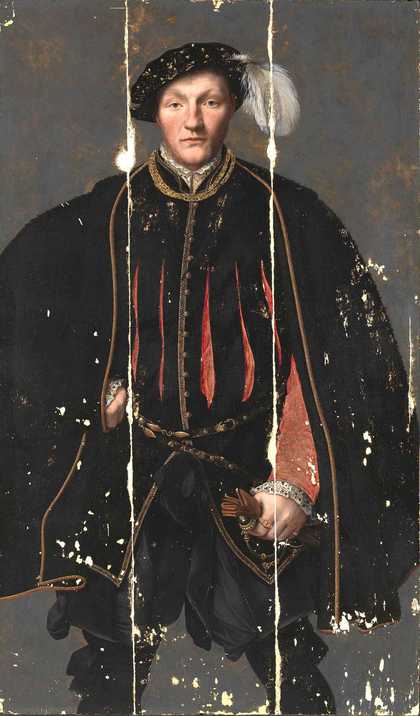
Fig.2
?British School
Portrait of a Gentleman, probably of the West Family c.1545–60 during conservation treatment
Tate
The earliest identified reference to this painting is in the catalogue of the third Exhibition of National Portraits at the South Kensington Museum in London in 1868, where it was described as a portrait of ‘William West, 1st Lord Delawarr by Hans Holbein’.1 However, the attribution to the German artist Hans Holbein the Younger (c.1497–1543), who worked at the court of King Henry VIII from 1526–8 and from 1532 until his death, has since been discounted on the basis of the painting’s style and handling when compared to known works by Holbein. This attribution was characteristic of nineteenth-century connoisseurship, reflecting not only an imperfect knowledge of the names and the number of artists who were active in sixteenth-century England, but also a desire to attribute surviving works to identified masters. The subject’s square-on, front-facing pose, however, is similar to that used by Holbein for his celebrated depiction of Henry VIII in the ‘Whitehall Mural’ of c.1537. Although the mural itself was destroyed in a fire in 1698, its appearance was known principally from a small copy made in the seventeenth century after which subsequent prints were made.2 But while nineteenth-century British viewers would have associated this pose principally with Holbein, other early portrait painters working on the continent had also employed it, and the painting is now described more securely, if vaguely, as ‘?British School’.3
In 1927 the Holford family, descendants of the painting’s 1868 owner, presented the portrait to the National Gallery, London, where it was initially displayed prominently. By this time it had appeared in a number of loan exhibitions at the Royal Academy and the Burlington Fine Arts Club, as well as the South Kensington Museum.4 In these exhibitions it was presented sometimes as a work by Holbein, but also variously attributed to two other immigrant painters who had worked in Tudor England: the Netherlander Guillim Stretes (or Scrots), and the German Gerlach Flicke.5 After the Second World War it was transferred to the Tate Gallery at Millbank.6 However, uncertainty about the painting, in particular its age, was registered in the entry compiled by the National Gallery curator Martin Davies in 1946, who noted that, ‘The flickering technique of this picture, and the apparent absence of any craquelure in the paint (except in the reds) are so abnormal that the compiler is unable to make a definite statement about the condition’. Davies also commented on ‘the shaggy flesh quality on the face’.7 By the 1990s the portrait had been consigned to Tate’s store in west London, where works that Tate did not expect to display were kept. At the time it was suspected to be a nineteenth-century pastiche, if not an outright fake, and at the instigation of Karen Hearn, the curator then responsible for sixteenth- and seventeenth-century works in Tate’s collection, the decision was taken to investigate the painting technically, and then to conserve it, a process that in the end extended over many years.8 Conservation treatment included the consolidation of raised and flaking paint, the removal of layers of dirt and discoloured varnish built up over many years, and the painstaking restoration of areas of lost original paint (fig.2). At the same time, Hearn consulted specialists in the fields of heraldry, dress history and weaponry, as well as art historians of sixteenth-century German, French, Netherlandish, Italian and Spanish painting to try to establish some facts about the subject and the origins of the painting.9
Heraldry
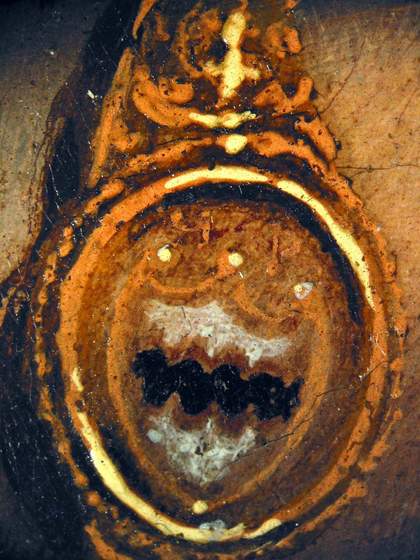
Fig.3
Detail of signet ring and the sitter’s coat of arms in ?British School, Portrait of a Gentleman, probably of the West Family c.1545–60
Tate
The sitter wears a signet ring on which heraldic arms are visibly depicted (fig.3). Such rings were often included in both English and European sixteenth-century male portraits.10 In 2010 Timothy Duke, Chester Herald of the College of Arms observed that in heralds’ terminology, the arms on the sitter’s ring appear to be ‘argent a fess dancetty sable’, that is, a white shield with a black central horizontal wavy line. These arms have been borne by a number of British families, including the de la Warr, Lawarr, and West families,11 but they have also been borne by continental European families. Moreover, as Duke has pointed out, if the colours or ‘tinctures’ of the arms were not in fact originally ‘argent and sable’ (that is, white and black), perhaps because the paint had faded or had changed colour over time, or if the shape of the fess (the horizontal wavy line) had been incorrectly depicted, then the field of enquiry would have to be broadened to include other families.12 However, it was the arms depicted on the sitter’s ring that prompted his nineteenth-century identification as William West (c.1519–1595), a man who apparently tried to poison his uncle, the 9th Lord de la Warre (died 1554), in order to gain his title and estates. His uncle survived, but West was convicted of the crime and disbarred from all honours, although he was later pardoned and in 1570 was created Baron de la Warr (sic), of the second creation.13
By way of comparison, a heraldic ring is depicted in the Portrait of Hans Roth, dated 1527, by the German painter Bernhard Strigel (c.1461–1528), which displays the sitter’s initials (an inverted ‘H R’) above his coat of arms (figs.4 and 5). A similar inscription, which reads ‘H P’, can be seen on the ring in the Tate painting. These initials do not seem to relate to William West and thus introduce an element of doubt regarding the identification of the sitter.
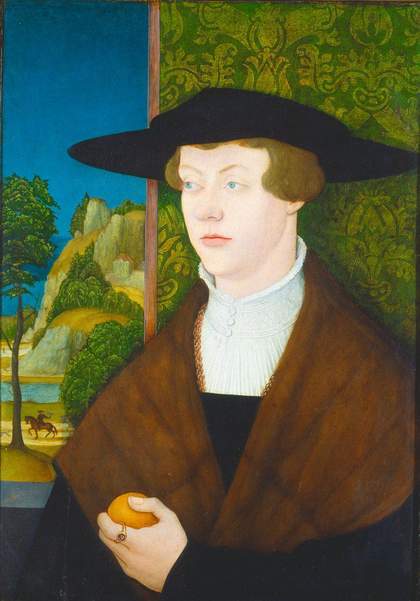
Fig.4
Bernhard Strigel
Portrait of Hans Roth 1527
Oil paint on panel
426 x 300 mm
National Gallery of Art, Washington
Courtesy National Gallery of Art, Washington
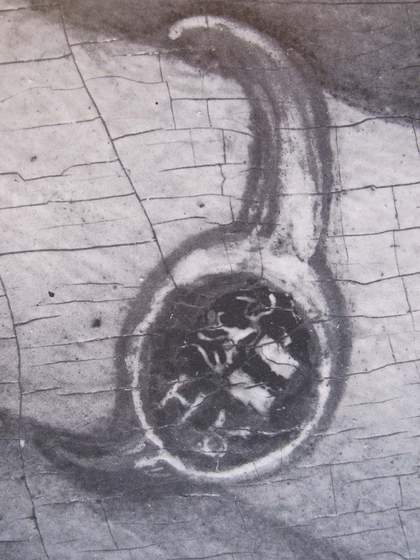
Fig.5
Detail of signet ring and the sitter’s initials in Bernhard Strigel, Portrait of Hans Roth 1527
National Gallery of Art, Washington
Courtesy National Gallery of Art, Washington
Costume and weaponry
On the basis of fashion, in 1997 the costume historian Janet Arnold dated the sitter’s attire to around the middle of the sixteenth century.14 More recently, the dress historian Maria Hayward has described the sitter’s soft velvet hat and his doublet as being ‘very fashionable in England from the 1520/30s to the 1550s. Unsecured cloaks of this type were worn from the 1540s to the end of the century, when short cut hair and short beards [of the type seen in this portrait] were also fashionable’. Hayward thus considers the costume to be English in style, although she does add that ‘male dress of this period was heavily influenced by Spanish and French dress’.15 Thus two leading specialists have found the dress depicted to be plausibly sixteenth-century in style, something that would have been unlikely if the portrait were a pastiche dating from the nineteenth century, by which time the numerous intricate details of early dress might well have been very hard to render correctly.
It can often be the case in early male portraits that a sitter’s weapons can yield useful information about dating and status. Unfortunately, in this painting the sitter’s leather gloves conceal part of the hilt of the sword, the very element that can be critical in dating weapons precisely. However, from what can be seen of the rapier and sword belt, A.V.B. Norman, formerly Master of the Armouries, suggested in 1997 that they would fit with the fashions in England of the 1540s to 1560. This again tends to support the idea that the work is not a later pastiche.16
Technical evidence
With the help of several external specialists, Tate conservators studied and analysed the underlying layers of the painting, which are largely hidden from view – namely the panel support, the ground layer, the underdrawing and the underpainting – before examining the surface paint layer itself. The ambition was to be able to match the technical characteristics of the painting to the craft traditions of a specific school of European painting, and, indeed, to the hallmark style of a known individual painter or workshop. By identifying the materials and techniques of the painting – using methods such as dendrochronology, X-ray examination, micropaleontology, infra red reflectography and pigment analysis – it was hoped that the sixteenth-century date could be proved or disproved.
Panel support
In sixteenth-century northern Europe, and particularly in England, the principal support for discrete paintings was wooden panel. Wood is comparatively fragile, and its vulnerability to changes in ambient humidity can cause it to warp or split. The larger the panel, the more vulnerable it is, and numerous English portraits that were painted on wooden panel must have been lost entirely, while many that do survive do so only in a cut-down form.17 An important tool for the study of paintings on wooden panel is dendrochronology, or tree-ring dating, a technique that uses the pattern of annual growth rings within a sample of timber to work out the years during which the tree from which it derived was growing. From England and elsewhere in north-western Europe there are now a large number of oak ring-width reference chronologies against which sequences can be tested.
The Tate panel is composed of three vertical boards. In 1997 Peter Klein, dendrochronologist at the University of Hamburg, conducted a dendrochronology examination of the painting, the results of which led Klein to conclude that the wood could be dated from 1527 onwards. The report also indicated that all three boards had been cut from the same Baltic-grown oak tree.18 Jacqueline Marette of the Museé de Louvre studied the wood species used by the various European schools of painting from the twelfth to the sixteenth centuries. Her findings published in 1961 showed that oak was used for only twenty per cent of German panels but was the predominant species used for paintings in France and Portugal, and was the wood used exclusively for panel paintings in the Low Countries.19 While Marette’s study had considerable limitations (it included few examples outside of French and Flemish public collections), it demonstrated the widespread use of oak as a painting support, and its findings have been supported by further subsequent studies.20 Although none of these published studies considered panel paintings painted in England, such pictures have been examined extensively as part of research projects at Tate and the National Portrait Gallery, London.21 Both institutions have found consistent use of oak in sixteenth- and early-seventeenth-century England that had been grown and exported from around the Baltic Sea. Although Baltic oak was exported in quantity, and was thus widely available throughout Europe, artists also chose to use materials that were found locally. For example, the German artist Albrecht Dürer (1471–1528) painted on poplar while he was staying in Venice, but on oak when he was in the Netherlands and southern Germany.22 Although a Baltic oak support cannot pinpoint a definite geographical origin for a painting, it largely rules out an Italian or Spanish derivation.

Fig.6
X-ray detail of the sitter’s head in
?British School, Portrait of a Gentleman, probably of the West Family c.1545–60
Tate
The boards of the Tate panel are butt-joined. X-radiography reveals that bridging each join are three tapered wooden dowels, indicated in X-rays by the contrast between their lighter shade against the darker surrounding panel (fig.6). The uppermost dowel, bridging the left join, is level with the top of the sitter’s hat. The widths of the three boards range between twenty-four and twenty-eight centimetres, which is typical of multi-board panels in use in northern Europe during the sixteenth century.23 Panels of the fifteenth and sixteenth centuries tended to be thicker than those used in the seventeenth century, and the twelve to fifteen millimetre depth of the Tate panel is notably thick, although not uncommon for panels that are painted on one side only.24 The fact that the sitter’s black cloak is cut off at both sides, and the three-quarter-length (rather than full-length) presentation of the figure has led to conjecture that the panel might have been reduced at a later date. However, the panel’s priming extends over the right-hand edge, with some brushstrokes ending at the top and bottom edges, and this, together with the regular spacing of the dowels and the positioning of the figure in the centre, suggests that the panel has not been significantly cut down.
A second dendrochronology examination of the panel was carried out in 2004 by Ian Tyers, who gave a usage date range of 1519–46, comparable to Peter Klein’s earlier dating of 1527 onwards.25 Interestingly, Tyers noted that the back of the panel shows some original splitting and tooling marks, which suggest that the boards were split out of one single, thicker panel to produce three. On the rear left-hand board, two lines, which have been cut with a gouge, form a V-shaped marking (fig.7). Such marks, which are not common, are thought to have been made by timber tradesmen in the Baltic who marked planks before they were shipped to the Hanseatic trading towns for further manufacturing, perhaps as a mark of ownership or of quality.26 No other panel in the Tate collection bears such a mark, but a similar marking is found on a panel of a late fifteenth-century triptych in the Frans Hals Museum in Haarlem in the Netherlands (fig.8). Comparable markings found on late fifteenth- and sixteenth-century Flemish paintings were published in a study conducted by conservators Hélène Verougstraete-Marcq and Roger van Schoute in 1989.27
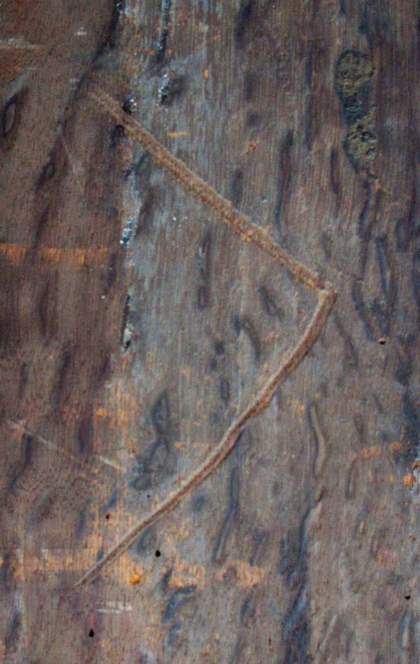
Fig.7
Detail of marking on the reverse of
?British School, Portrait of a Gentleman, probably of the West Family c.1545–60
Tate
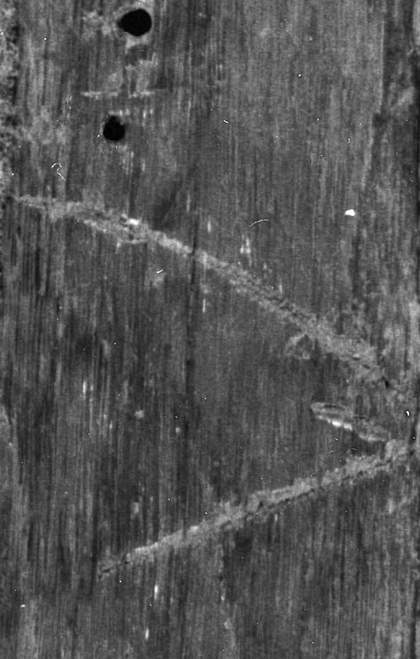
Fig.8
Detail of marking on the reverse of The Lamentation of Christ c.1498 by a follower of Geertgen tot sint Jans
Frans Hals Museum, Haarlem
Ground layer
In northern Europe, until the end of the sixteenth century, wooden panel supports were traditionally primed using a ground of chalk bound in animal glue. The Tate panel was found to be prepared in such a way with a ground measuring 0.15 mm in thickness. This matches the generally thin layers found on Flemish and Netherlandish oak panels of less than 0.2 mm, compared with the thicker gesso grounds on poplar panels painted in Italy during the same period.28 These findings thus suggest that the panel was not prepared in Spain or Italy.
Tate also commissioned micropalaeontology to see whether a study of the chalk in the ground might identify the origin of the painting. Studying nanofossils in chalk can prove useful because the ages of rocks change significantly across relatively short distances. Certain chalks are found in Belgium and Holland but not in England, for example.29 Unfortunately the most that could be concluded from analysis of a sample from the Tate painting was that similar sediments are found ‘significantly closer to London than Bruges’.30
Underdrawing
Since the 1970s much has been published about underdrawing as a feature of panel paintings and about how it can be detected using infrared reflectography, which can reveal the presence of drawing (in certain media) under the paint layers. In the Tate portrait, underdrawn lines can be seen marking the contours of the facial features: the lips, nose, eyes, a short vertical frown line at the centre of the forehead, and a crease on the right cheek (fig.9). Examination of these infrared images by specialist conservator Rachel Billinge suggested a ‘traced positioning of the main features, perhaps based on a cartoon, which was then strengthened and fixed with a liquid medium line. In places a double line is visible, one much fainter than the other, most clearly in the lips’.31 The basic drawing was then elaborated freehand with short zigzag lines, like streaks of lightning, which can be seen most clearly on the sitter’s left hand (fig.10).
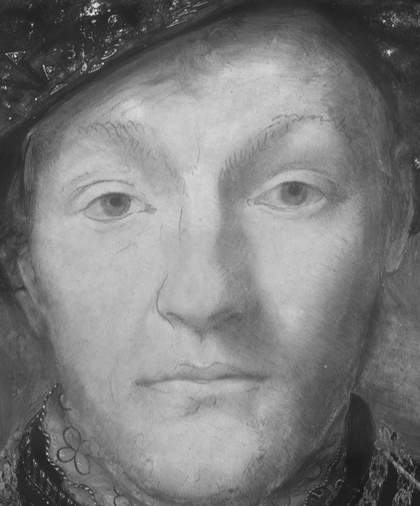
Fig.9
Detail in infrared light of the sitter’s face in ?British School, Portrait of a Gentleman, probably of the West Family c.1545–60
Tate
Photo: Rachel Billinge
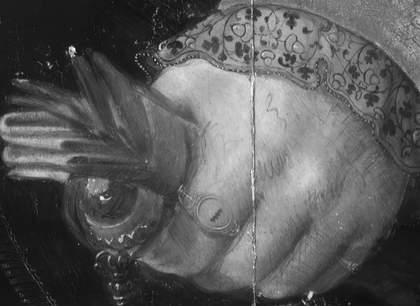
Fig.10
Detail in infrared light of the sitter’s left hand in ?British School, Portrait of a Gentleman, probably of the West Family c.1545–60
Tate
Photo: Rachel Billinge
Underpaint
While a second priming layer was applied over the entire panel, a mid-brown underpaint, as seen in cross section, composed of charcoal black, brown ochre and transparent yellow and brown pigments was applied exclusively beneath the background surrounding the figure.32 The purpose of this underpaint is not fully understood. The now somewhat abraded blue-grey paint on top includes more charcoal black, lead white, a few particles of ultramarine and smalt. The smalt – a rich blue pigment that can discolour over time to a muddy brown or grey – may have caused the discolouration of the binding medium of the underpaint, and may also originally have imparted a brighter blue hue to the background, which would have echoed the strong blue backgrounds seen in some of Hans Holbein’s English portraits.33
Paint
The paint itself is applied in thin, even layers. The only significant difference in its thickness can be found in the red sleeve and the red doublet revealed by the slashes in the sitter’s jerkin. To identify pigments in the paint, minute samples, as little as ten microns in size, were taken from damage sites such as those along the panel joins revealed during conservation treatment. Paint cross-sections (samples embedded in resin and polished to reveal the sequence of paint layers) were taken from the red sleeve. They revealed a yellow-pigmented underlayer beneath the red, which acts as a mordant to a layer of silver leaf, hence the additional depth of paint. European artists from the fourteenth century onwards frequently used silver leaf under coloured glazes to add a jewel-like brilliance to the colours, despite the propensity of silver to tarnish.34 Indeed, the use of silver leaf beneath red glazes has been identified on a number of top quality English panel paintings of the mid-sixteenth century, including a full-length portrait of Edward VI of about 1547 by an unknown artist, and Katherine Parr c.1545 by ‘Master John’, both in the National Portrait Gallery, London.35 The use of metal leaf beneath coloured glazes on paintings painted in later centuries, however, is not generally seen. In the Tate painting, the effect of the underlying, tarnished silver is now largely imperceptible.
To identify the organic constituent of the red glaze, high performance liquid chromatography (HPLC) was carried out.36 The analysis detected cochineal, due to the presence of carminic acid. An additional trace of ellagic acid indicated the use of galls and revealed that the dyestuff was extracted from silk, a well-known and almost exclusive method for extracting the dye used in lake pigment manufacture in the sixteenth and probably the seventeenth century as well.
Other pigments found in the painting are equally typical of the sixteenth century, and include the lead tin yellow which has been used to depict gold threads in the braid of the sitter’s cloak and jerkin, and the gold and black thread bow at his neck. Lead tin yellow seems to have been used between 1300 and 1750, after which date it inexplicably fell out of use until it was rediscovered at the Doerner Institute, Munich, in 1941.37 As lead tin yellow does not appear in nineteenth-century paintings (or, indeed, in pastiches produced prior to its rediscovery), its identification in the Tate painting provides further evidence for a mid-sixteenth century production date.
The sitter’s ring is not damaged and there is no evidence for colour change due to aging of its materials, suggesting the heraldic ‘argent and sable’ colours have not altered. The intact condition of the paint means that paint sampling, a technique that is typically carried out at the edges of existing damage, would be inappropriate.
Style and handling
To complement the analyses of the paint and its layer structure, the style and handling of the paint were also assessed. Conservation treatment of the painting, specifically the removal of layers of dirt and discoloured varnish, and restoration, helped improve analysis and interpretation of the dress. The square collar of the cloak, painted as if seen from the reverse, has edges at the shoulders that became clearer after cleaning, as did the texture of the black fur or velvet cloak fabric. Further definition, such as revers in the cloak displaying the lining fabric, was not revealed and it is felt that the flat areas of black are somewhat formulaic in handling, and may indicate the work of studio assistants. It should, however, be considered that the characterisation of folds may have been lost through abrasion or deterioration of the paint, just as the impact of the red sleeves and slashes has been reduced through the fading of the pigment and the tarnishing of the silver leaf. The face, the decorative detailing of the dress, and the tonal changes in the gathered hose are, by contrast, very accomplished and seem to be the work of a well-trained master painter.
The aspect of the painting that has continued to baffle art historians and curators is the ‘hatched’ technique used for the flesh paint in the face (fig.11) and hands. It is not typical of sixteenth-century painting practice in England, as can be illustrated by comparing the face with that from A Man in a Black Cap 1545 (Tate N01496), by the English artist John Bettes (fig.12).38 These distinctive, fine, diagonal paint strokes are reminiscent both of tempera painting and of the later Italian retouching technique tratteggio. It has been suggested that the brushstrokes might result from a portrait miniaturist adapting his small-scale watercolour technique to a larger format, although the unidirectional nature of the strokes seems to discredit this theory. The unusual appearance of the flesh paint has also led to speculation that a skilful restorer, perhaps in the nineteenth century, might have repainted the face over a damaged or abraded original. Microscopic examination, however, revealed no earlier paint layer or attempts to abrade and repaint while leaving the underdrawing intact. Nor is there any evidence of a border where a much later paint layer might have met the original but damaged paint. This assessment is backed up by a lack of reworking of the lead white containing flesh paint visible on the X-radiograph of the face (fig.6).
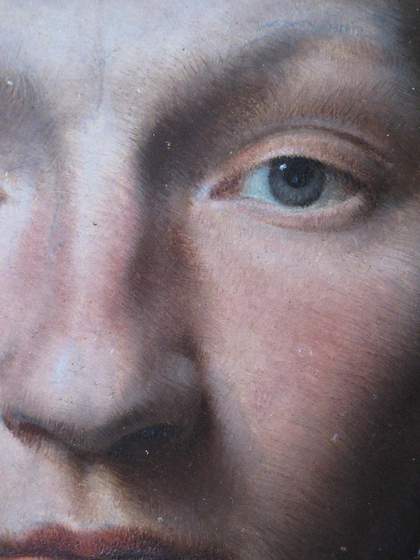
Fig.11
Detail of the hatched technique used to paint the sitter’s face in ?British School, Portrait of a Gentleman, probably of the West Family c.1545–60
Tate
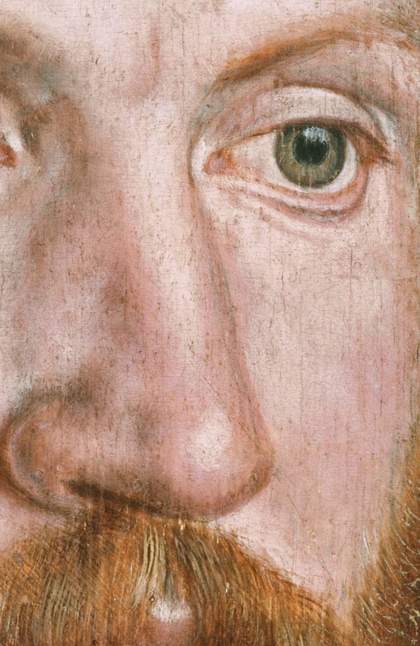
Fig.12
Detail of the sitter’s face in John Bettes, A Man in a Black Cap 1545
Tate
In conclusion, it can be affirmed that all the painting materials used in the portrait that have been analysed would have been readily available to an artist working in Britain in the sixteenth century, sourced either directly from Britain or from the Low Countries. The findings of lead tin yellow, smalt and silk-extracted cochineal mean that previous suggestions that the background and costume were painted in the nineteenth century can be discounted, and the practice of using silver leaf beneath glazes would have been unfamiliar to a nineteenth-century pasticheur. Although the repainting of the face by a talented later restorer cannot totally be discounted, there is no material evidence to support that theory.
Technical examination also indicated that the portrait is in its original format, and has not been significantly cut down. The compression of the figure at both sides is therefore intentional, making the pose more dynamic and confrontational. The construction and dating of the Baltic oak panel, the painting materials used, and the costume of the sitter are all consistent with a mid-sixteenth-century date. Dendrochronology suggests a post-1527 date of painting, while the fashion of the costume and weaponry narrows it down to the later 1540s–50s, thus rendering an attribution to Hans Holbein the Younger, who died in 1543, impossible. However, this date range does lie within William West’s adult lifetime, and the sitter’s appearance in the painting is consistent with West’s age at that time. A dating of 1570, however, when West was elevated to a barony and might have wished to have himself painted to mark that honour, cannot be posited, since it would be too late not only for the fashion of the dress, but also for the age and appearance of the sitter. Thus this portrait, which is one of Tate’s very few Tudor-period works, seems after all to be one of the oldest paintings in the collection, although uncertainty remains about the artist and the identity of the figure. 39
